Ethics, Sustainability and Social Impact
VerifiedAdded on 2023/01/12
|13
|3828
|33
AI Summary
This report discusses the ethics, sustainability, and social impact of plastic pollution and the efforts of The Coca-Cola Company towards circular economy. It explores the causes and effects of plastic pollution, the influence of circular economy on business organizations, and the implementation of circular economy principles by The Coca-Cola Company. The report highlights the need to address plastic pollution and the steps taken by The Coca-Cola Company to reduce plastic wastage and pollution.
Contribute Materials
Your contribution can guide someone’s learning journey. Share your
documents today.
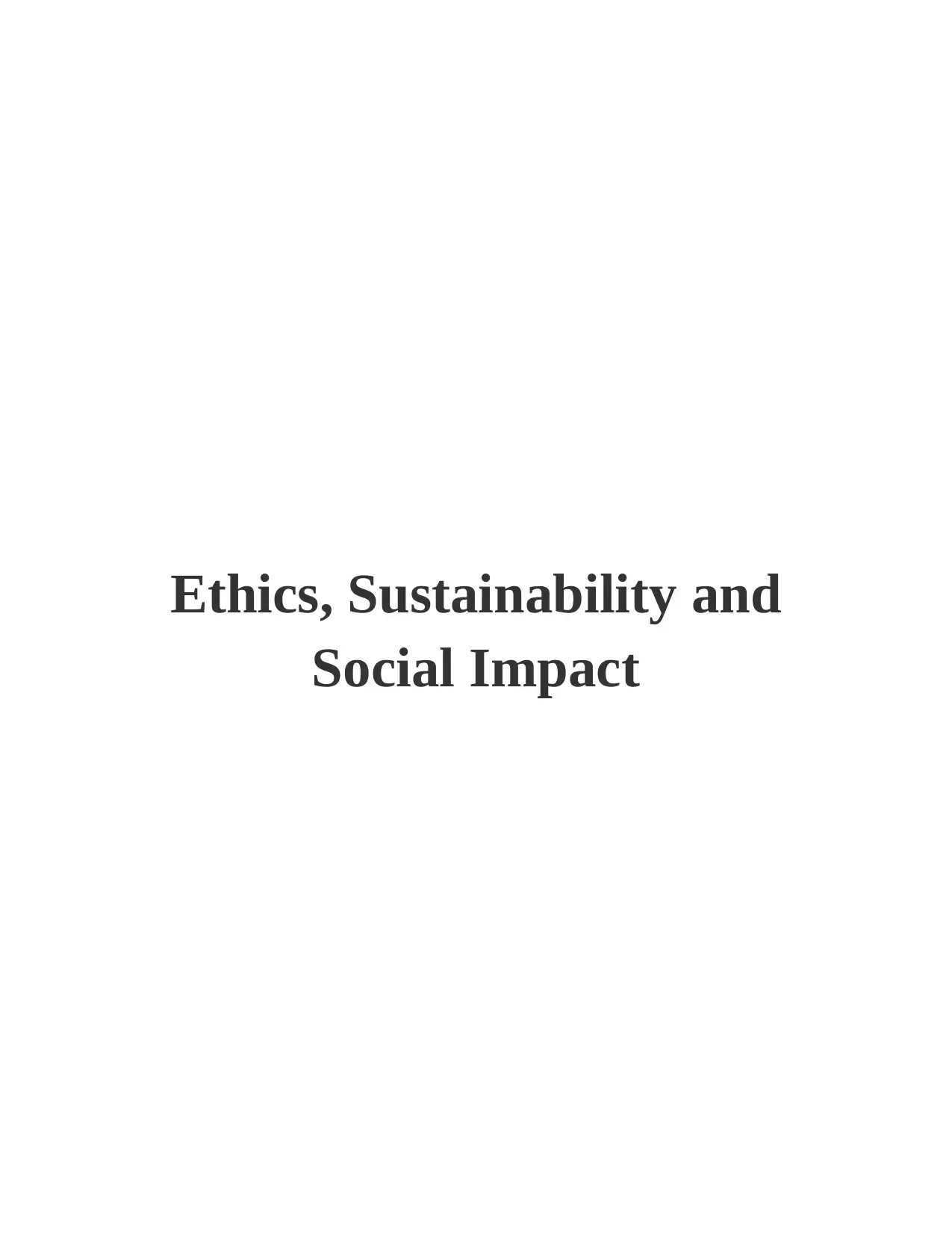
Ethics, Sustainability and
Social Impact
Social Impact
Secure Best Marks with AI Grader
Need help grading? Try our AI Grader for instant feedback on your assignments.

Table of Contents
INTRODUCTION...........................................................................................................................3
Main Body.......................................................................................................................................3
Causes and Effects of Plastic Pollution.......................................................................................3
Circular Economy and its Influence............................................................................................5
The Coca-Cola Company’s Efforts Towards Circular Economy................................................8
CONCLUSION..............................................................................................................................10
REFERENCES..............................................................................................................................11
INTRODUCTION...........................................................................................................................3
Main Body.......................................................................................................................................3
Causes and Effects of Plastic Pollution.......................................................................................3
Circular Economy and its Influence............................................................................................5
The Coca-Cola Company’s Efforts Towards Circular Economy................................................8
CONCLUSION..............................................................................................................................10
REFERENCES..............................................................................................................................11
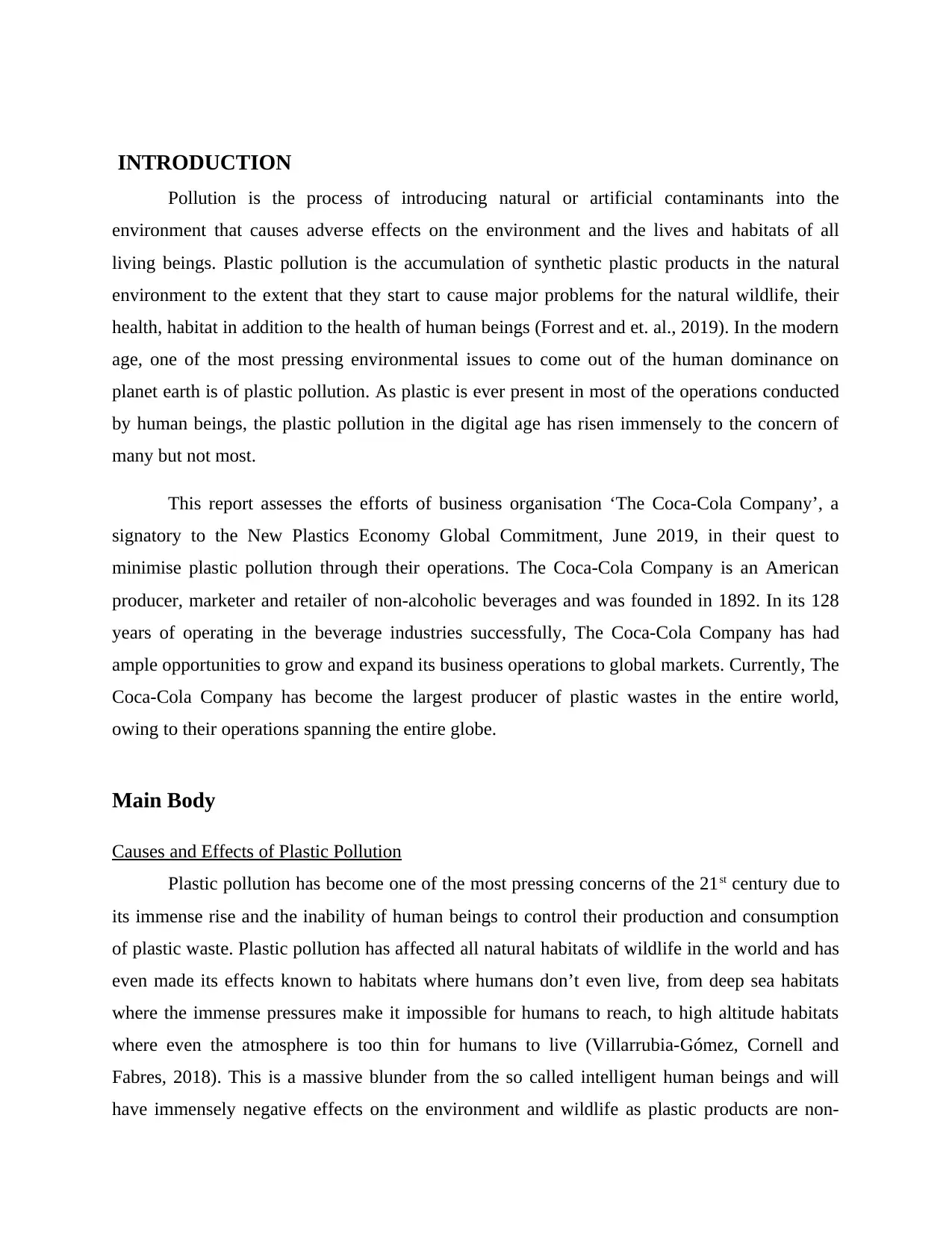
INTRODUCTION
Pollution is the process of introducing natural or artificial contaminants into the
environment that causes adverse effects on the environment and the lives and habitats of all
living beings. Plastic pollution is the accumulation of synthetic plastic products in the natural
environment to the extent that they start to cause major problems for the natural wildlife, their
health, habitat in addition to the health of human beings (Forrest and et. al., 2019). In the modern
age, one of the most pressing environmental issues to come out of the human dominance on
planet earth is of plastic pollution. As plastic is ever present in most of the operations conducted
by human beings, the plastic pollution in the digital age has risen immensely to the concern of
many but not most.
This report assesses the efforts of business organisation ‘The Coca-Cola Company’, a
signatory to the New Plastics Economy Global Commitment, June 2019, in their quest to
minimise plastic pollution through their operations. The Coca-Cola Company is an American
producer, marketer and retailer of non-alcoholic beverages and was founded in 1892. In its 128
years of operating in the beverage industries successfully, The Coca-Cola Company has had
ample opportunities to grow and expand its business operations to global markets. Currently, The
Coca-Cola Company has become the largest producer of plastic wastes in the entire world,
owing to their operations spanning the entire globe.
Main Body
Causes and Effects of Plastic Pollution
Plastic pollution has become one of the most pressing concerns of the 21st century due to
its immense rise and the inability of human beings to control their production and consumption
of plastic waste. Plastic pollution has affected all natural habitats of wildlife in the world and has
even made its effects known to habitats where humans don’t even live, from deep sea habitats
where the immense pressures make it impossible for humans to reach, to high altitude habitats
where even the atmosphere is too thin for humans to live (Villarrubia-Gómez, Cornell and
Fabres, 2018). This is a massive blunder from the so called intelligent human beings and will
have immensely negative effects on the environment and wildlife as plastic products are non-
Pollution is the process of introducing natural or artificial contaminants into the
environment that causes adverse effects on the environment and the lives and habitats of all
living beings. Plastic pollution is the accumulation of synthetic plastic products in the natural
environment to the extent that they start to cause major problems for the natural wildlife, their
health, habitat in addition to the health of human beings (Forrest and et. al., 2019). In the modern
age, one of the most pressing environmental issues to come out of the human dominance on
planet earth is of plastic pollution. As plastic is ever present in most of the operations conducted
by human beings, the plastic pollution in the digital age has risen immensely to the concern of
many but not most.
This report assesses the efforts of business organisation ‘The Coca-Cola Company’, a
signatory to the New Plastics Economy Global Commitment, June 2019, in their quest to
minimise plastic pollution through their operations. The Coca-Cola Company is an American
producer, marketer and retailer of non-alcoholic beverages and was founded in 1892. In its 128
years of operating in the beverage industries successfully, The Coca-Cola Company has had
ample opportunities to grow and expand its business operations to global markets. Currently, The
Coca-Cola Company has become the largest producer of plastic wastes in the entire world,
owing to their operations spanning the entire globe.
Main Body
Causes and Effects of Plastic Pollution
Plastic pollution has become one of the most pressing concerns of the 21st century due to
its immense rise and the inability of human beings to control their production and consumption
of plastic waste. Plastic pollution has affected all natural habitats of wildlife in the world and has
even made its effects known to habitats where humans don’t even live, from deep sea habitats
where the immense pressures make it impossible for humans to reach, to high altitude habitats
where even the atmosphere is too thin for humans to live (Villarrubia-Gómez, Cornell and
Fabres, 2018). This is a massive blunder from the so called intelligent human beings and will
have immensely negative effects on the environment and wildlife as plastic products are non-

biodegradable and are able to persist in the environment for thousands of years. There are
multiple reasons as to why plastic pollution in the environment has become so prevalent all
around the globe such as:
Versatility: As plastic was created by human beings, it was designed to be immensely versatile in
its applications. Plastic materials can be moulded into various shapes, sizes and forms and this
versatility that plastic provides has become the major cause of growing plastic pollution in the
entire world (Xanthos and Walker, 2017). Nowadays plastic products have made their way into
almost every consumer product and industry’s operations due to their versatility. From plastic
bottles to plastic containers to plastic bags to almost everything, plastic has made its way into
most human operations owing to their versatility.
Economic Feasibility: Plastic is also significantly cheaper than all of its current alternatives in
the market and is significantly easy to produce. This is the second biggest reason why businesses
all around the globe have incorporated plastic into their operations, causing plastic pollution to
rise to alarming rates everywhere. As plastic is more economically feasible for business
organisation’s operations and helps their objective of generating increased profits, irrespective of
the damage or cost to the environment, the average consumer has little choice but to purchase
these goods and products that are packaged in plastic containers and bags.
Non-Biodegradable: Plastic was designed and created by human being to last. Though this was a
revolutionary idea in the 20th century, in the 21st century the world now understands what this
design entails for the environment and the wildlife around as. As plastic is a synthetic product
created in laboratory and not found in any natural environment, there are no natural bacteria or
natural biological processes than can break down its polymer structure (Haward, 2018). This
means that all the plastic wastes in the environment can last for thousands of years in the
environment and if consumed by wildlife cannot be broken down by their digestion systems,
making them unfortunately ever present in the ecosystem.
Rise in plastic pollution in the 21st century has had immensely negative impact on the
entire world’s ecosystems, wildlife and habitats. Plastic pollution’s effects are more far reaching
than anyone imagined, some of which are as follows:
multiple reasons as to why plastic pollution in the environment has become so prevalent all
around the globe such as:
Versatility: As plastic was created by human beings, it was designed to be immensely versatile in
its applications. Plastic materials can be moulded into various shapes, sizes and forms and this
versatility that plastic provides has become the major cause of growing plastic pollution in the
entire world (Xanthos and Walker, 2017). Nowadays plastic products have made their way into
almost every consumer product and industry’s operations due to their versatility. From plastic
bottles to plastic containers to plastic bags to almost everything, plastic has made its way into
most human operations owing to their versatility.
Economic Feasibility: Plastic is also significantly cheaper than all of its current alternatives in
the market and is significantly easy to produce. This is the second biggest reason why businesses
all around the globe have incorporated plastic into their operations, causing plastic pollution to
rise to alarming rates everywhere. As plastic is more economically feasible for business
organisation’s operations and helps their objective of generating increased profits, irrespective of
the damage or cost to the environment, the average consumer has little choice but to purchase
these goods and products that are packaged in plastic containers and bags.
Non-Biodegradable: Plastic was designed and created by human being to last. Though this was a
revolutionary idea in the 20th century, in the 21st century the world now understands what this
design entails for the environment and the wildlife around as. As plastic is a synthetic product
created in laboratory and not found in any natural environment, there are no natural bacteria or
natural biological processes than can break down its polymer structure (Haward, 2018). This
means that all the plastic wastes in the environment can last for thousands of years in the
environment and if consumed by wildlife cannot be broken down by their digestion systems,
making them unfortunately ever present in the ecosystem.
Rise in plastic pollution in the 21st century has had immensely negative impact on the
entire world’s ecosystems, wildlife and habitats. Plastic pollution’s effects are more far reaching
than anyone imagined, some of which are as follows:
Secure Best Marks with AI Grader
Need help grading? Try our AI Grader for instant feedback on your assignments.
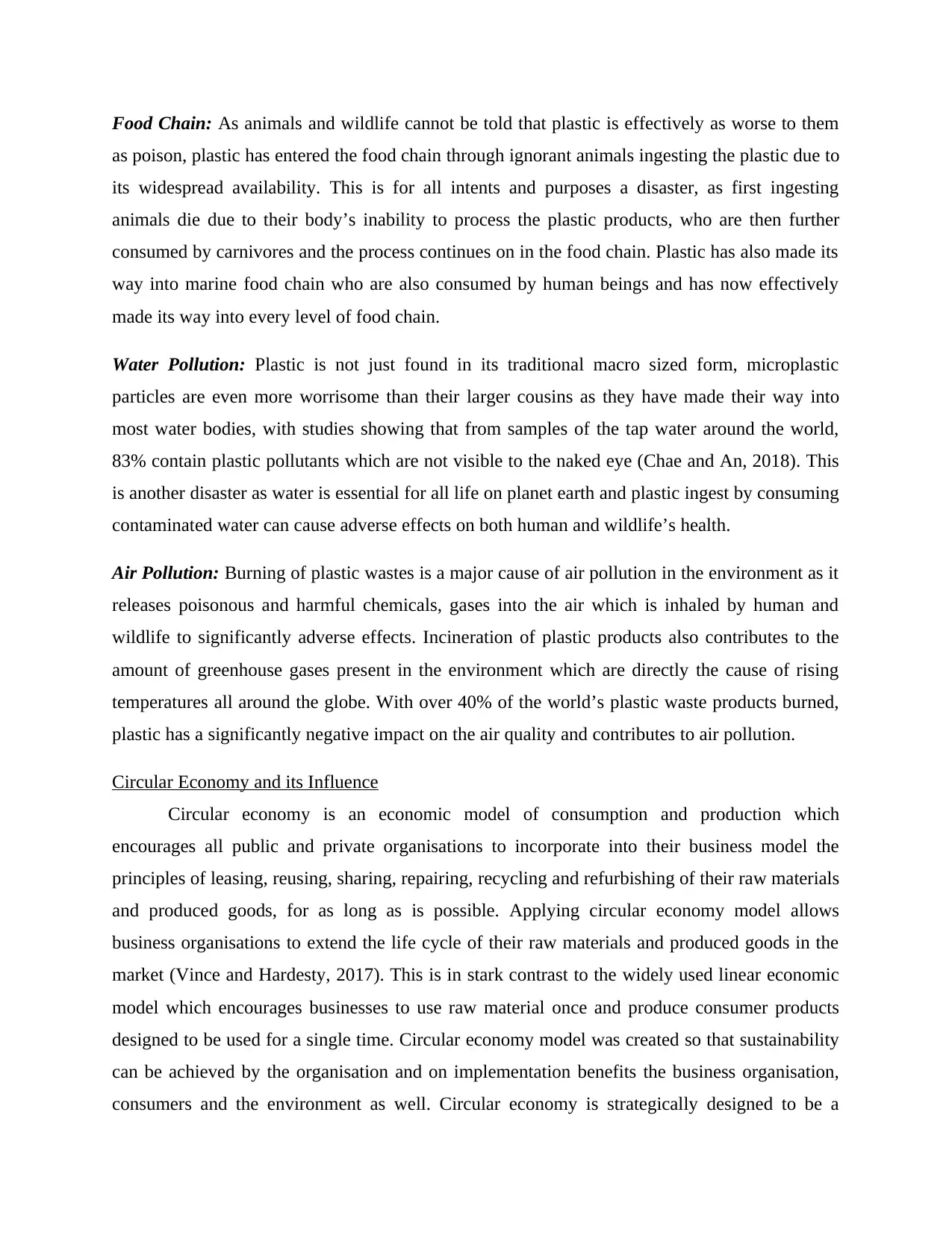
Food Chain: As animals and wildlife cannot be told that plastic is effectively as worse to them
as poison, plastic has entered the food chain through ignorant animals ingesting the plastic due to
its widespread availability. This is for all intents and purposes a disaster, as first ingesting
animals die due to their body’s inability to process the plastic products, who are then further
consumed by carnivores and the process continues on in the food chain. Plastic has also made its
way into marine food chain who are also consumed by human beings and has now effectively
made its way into every level of food chain.
Water Pollution: Plastic is not just found in its traditional macro sized form, microplastic
particles are even more worrisome than their larger cousins as they have made their way into
most water bodies, with studies showing that from samples of the tap water around the world,
83% contain plastic pollutants which are not visible to the naked eye (Chae and An, 2018). This
is another disaster as water is essential for all life on planet earth and plastic ingest by consuming
contaminated water can cause adverse effects on both human and wildlife’s health.
Air Pollution: Burning of plastic wastes is a major cause of air pollution in the environment as it
releases poisonous and harmful chemicals, gases into the air which is inhaled by human and
wildlife to significantly adverse effects. Incineration of plastic products also contributes to the
amount of greenhouse gases present in the environment which are directly the cause of rising
temperatures all around the globe. With over 40% of the world’s plastic waste products burned,
plastic has a significantly negative impact on the air quality and contributes to air pollution.
Circular Economy and its Influence
Circular economy is an economic model of consumption and production which
encourages all public and private organisations to incorporate into their business model the
principles of leasing, reusing, sharing, repairing, recycling and refurbishing of their raw materials
and produced goods, for as long as is possible. Applying circular economy model allows
business organisations to extend the life cycle of their raw materials and produced goods in the
market (Vince and Hardesty, 2017). This is in stark contrast to the widely used linear economic
model which encourages businesses to use raw material once and produce consumer products
designed to be used for a single time. Circular economy model was created so that sustainability
can be achieved by the organisation and on implementation benefits the business organisation,
consumers and the environment as well. Circular economy is strategically designed to be a
as poison, plastic has entered the food chain through ignorant animals ingesting the plastic due to
its widespread availability. This is for all intents and purposes a disaster, as first ingesting
animals die due to their body’s inability to process the plastic products, who are then further
consumed by carnivores and the process continues on in the food chain. Plastic has also made its
way into marine food chain who are also consumed by human beings and has now effectively
made its way into every level of food chain.
Water Pollution: Plastic is not just found in its traditional macro sized form, microplastic
particles are even more worrisome than their larger cousins as they have made their way into
most water bodies, with studies showing that from samples of the tap water around the world,
83% contain plastic pollutants which are not visible to the naked eye (Chae and An, 2018). This
is another disaster as water is essential for all life on planet earth and plastic ingest by consuming
contaminated water can cause adverse effects on both human and wildlife’s health.
Air Pollution: Burning of plastic wastes is a major cause of air pollution in the environment as it
releases poisonous and harmful chemicals, gases into the air which is inhaled by human and
wildlife to significantly adverse effects. Incineration of plastic products also contributes to the
amount of greenhouse gases present in the environment which are directly the cause of rising
temperatures all around the globe. With over 40% of the world’s plastic waste products burned,
plastic has a significantly negative impact on the air quality and contributes to air pollution.
Circular Economy and its Influence
Circular economy is an economic model of consumption and production which
encourages all public and private organisations to incorporate into their business model the
principles of leasing, reusing, sharing, repairing, recycling and refurbishing of their raw materials
and produced goods, for as long as is possible. Applying circular economy model allows
business organisations to extend the life cycle of their raw materials and produced goods in the
market (Vince and Hardesty, 2017). This is in stark contrast to the widely used linear economic
model which encourages businesses to use raw material once and produce consumer products
designed to be used for a single time. Circular economy model was created so that sustainability
can be achieved by the organisation and on implementation benefits the business organisation,
consumers and the environment as well. Circular economy is strategically designed to be a

regenerative process, with the overall objective to decouple organisation’s operations from
consumption of finite resources available in the markets.
Figure 1: Circular and Linear Economic Models
The concept of creating circular economy cannot be attributed to any single author or
business organisation, interestingly circular economy has various deeply rooted origins and came
out of many distinct business models through the ages (Ritchie and Roser, 2018). However, since
the 1970s, the concept and application of circular economy has become popular in business
organisation’s processes and economic systems based on various theories such as the Cradle to
Cradle framework, Performance economy model, Biomimicry: Inspired by Nature book,
Industrial Ecology framework, Blue Economy model etc.
There are 3 main principles of circular economy which all business organisations have to
implement into their business processes and operations in order to achieve circular economy as
follows:
Eliminate pollution and Waste: A circular economy identifies, redesigns and innovates out the
processes and functions of their operations which have a negative impact on the environment,
ecosystems, habitats, wildlife and human beings (Bergmann, Tekman and Gutow, 2017). This
include their operational processes and functions which generate hazardous greenhouse gases
and chemicals, pollute the environment in any capacity and as well as minimise wastage.
consumption of finite resources available in the markets.
Figure 1: Circular and Linear Economic Models
The concept of creating circular economy cannot be attributed to any single author or
business organisation, interestingly circular economy has various deeply rooted origins and came
out of many distinct business models through the ages (Ritchie and Roser, 2018). However, since
the 1970s, the concept and application of circular economy has become popular in business
organisation’s processes and economic systems based on various theories such as the Cradle to
Cradle framework, Performance economy model, Biomimicry: Inspired by Nature book,
Industrial Ecology framework, Blue Economy model etc.
There are 3 main principles of circular economy which all business organisations have to
implement into their business processes and operations in order to achieve circular economy as
follows:
Eliminate pollution and Waste: A circular economy identifies, redesigns and innovates out the
processes and functions of their operations which have a negative impact on the environment,
ecosystems, habitats, wildlife and human beings (Bergmann, Tekman and Gutow, 2017). This
include their operational processes and functions which generate hazardous greenhouse gases
and chemicals, pollute the environment in any capacity and as well as minimise wastage.
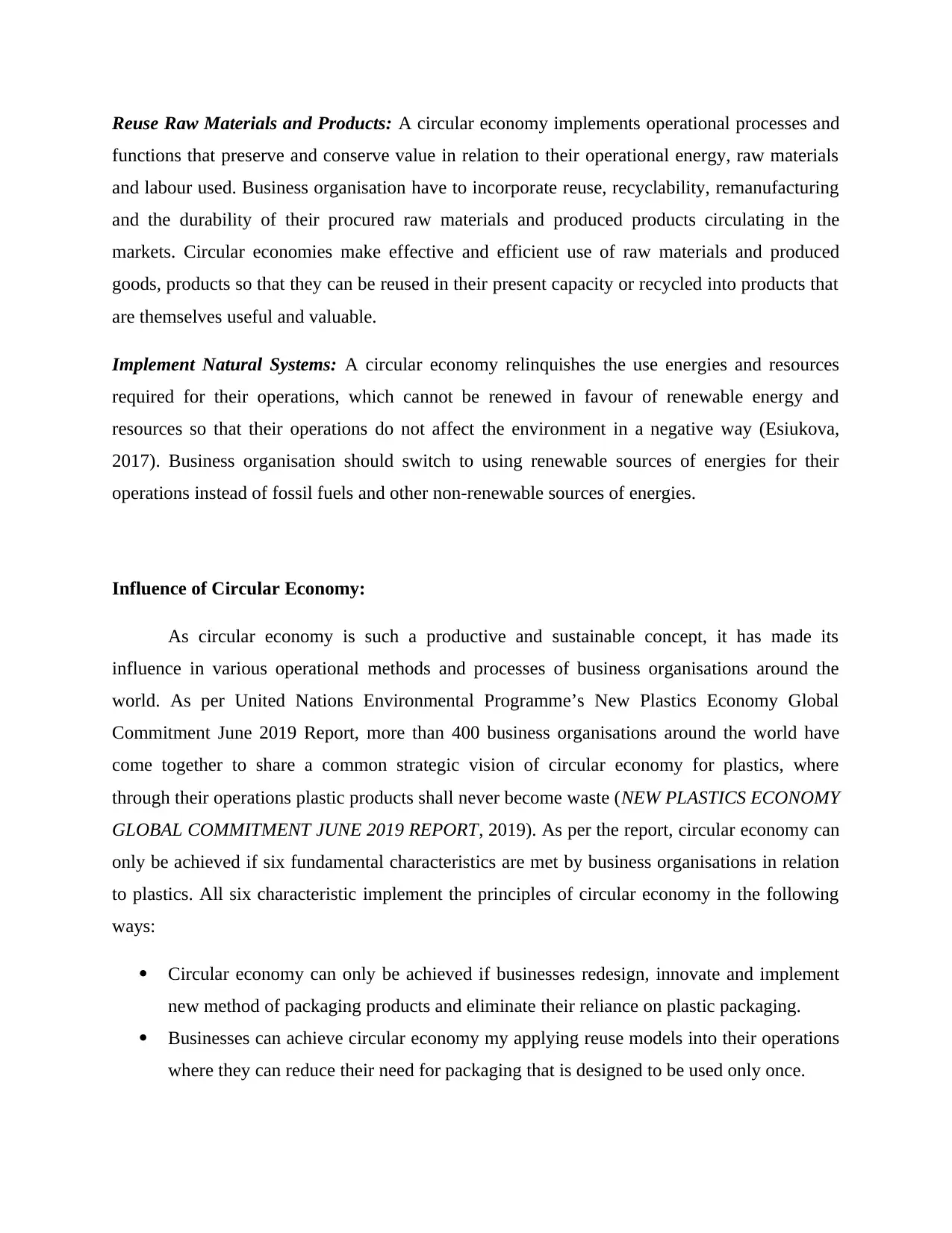
Reuse Raw Materials and Products: A circular economy implements operational processes and
functions that preserve and conserve value in relation to their operational energy, raw materials
and labour used. Business organisation have to incorporate reuse, recyclability, remanufacturing
and the durability of their procured raw materials and produced products circulating in the
markets. Circular economies make effective and efficient use of raw materials and produced
goods, products so that they can be reused in their present capacity or recycled into products that
are themselves useful and valuable.
Implement Natural Systems: A circular economy relinquishes the use energies and resources
required for their operations, which cannot be renewed in favour of renewable energy and
resources so that their operations do not affect the environment in a negative way (Esiukova,
2017). Business organisation should switch to using renewable sources of energies for their
operations instead of fossil fuels and other non-renewable sources of energies.
Influence of Circular Economy:
As circular economy is such a productive and sustainable concept, it has made its
influence in various operational methods and processes of business organisations around the
world. As per United Nations Environmental Programme’s New Plastics Economy Global
Commitment June 2019 Report, more than 400 business organisations around the world have
come together to share a common strategic vision of circular economy for plastics, where
through their operations plastic products shall never become waste (NEW PLASTICS ECONOMY
GLOBAL COMMITMENT JUNE 2019 REPORT, 2019). As per the report, circular economy can
only be achieved if six fundamental characteristics are met by business organisations in relation
to plastics. All six characteristic implement the principles of circular economy in the following
ways:
Circular economy can only be achieved if businesses redesign, innovate and implement
new method of packaging products and eliminate their reliance on plastic packaging.
Businesses can achieve circular economy my applying reuse models into their operations
where they can reduce their need for packaging that is designed to be used only once.
functions that preserve and conserve value in relation to their operational energy, raw materials
and labour used. Business organisation have to incorporate reuse, recyclability, remanufacturing
and the durability of their procured raw materials and produced products circulating in the
markets. Circular economies make effective and efficient use of raw materials and produced
goods, products so that they can be reused in their present capacity or recycled into products that
are themselves useful and valuable.
Implement Natural Systems: A circular economy relinquishes the use energies and resources
required for their operations, which cannot be renewed in favour of renewable energy and
resources so that their operations do not affect the environment in a negative way (Esiukova,
2017). Business organisation should switch to using renewable sources of energies for their
operations instead of fossil fuels and other non-renewable sources of energies.
Influence of Circular Economy:
As circular economy is such a productive and sustainable concept, it has made its
influence in various operational methods and processes of business organisations around the
world. As per United Nations Environmental Programme’s New Plastics Economy Global
Commitment June 2019 Report, more than 400 business organisations around the world have
come together to share a common strategic vision of circular economy for plastics, where
through their operations plastic products shall never become waste (NEW PLASTICS ECONOMY
GLOBAL COMMITMENT JUNE 2019 REPORT, 2019). As per the report, circular economy can
only be achieved if six fundamental characteristics are met by business organisations in relation
to plastics. All six characteristic implement the principles of circular economy in the following
ways:
Circular economy can only be achieved if businesses redesign, innovate and implement
new method of packaging products and eliminate their reliance on plastic packaging.
Businesses can achieve circular economy my applying reuse models into their operations
where they can reduce their need for packaging that is designed to be used only once.
Paraphrase This Document
Need a fresh take? Get an instant paraphrase of this document with our AI Paraphraser
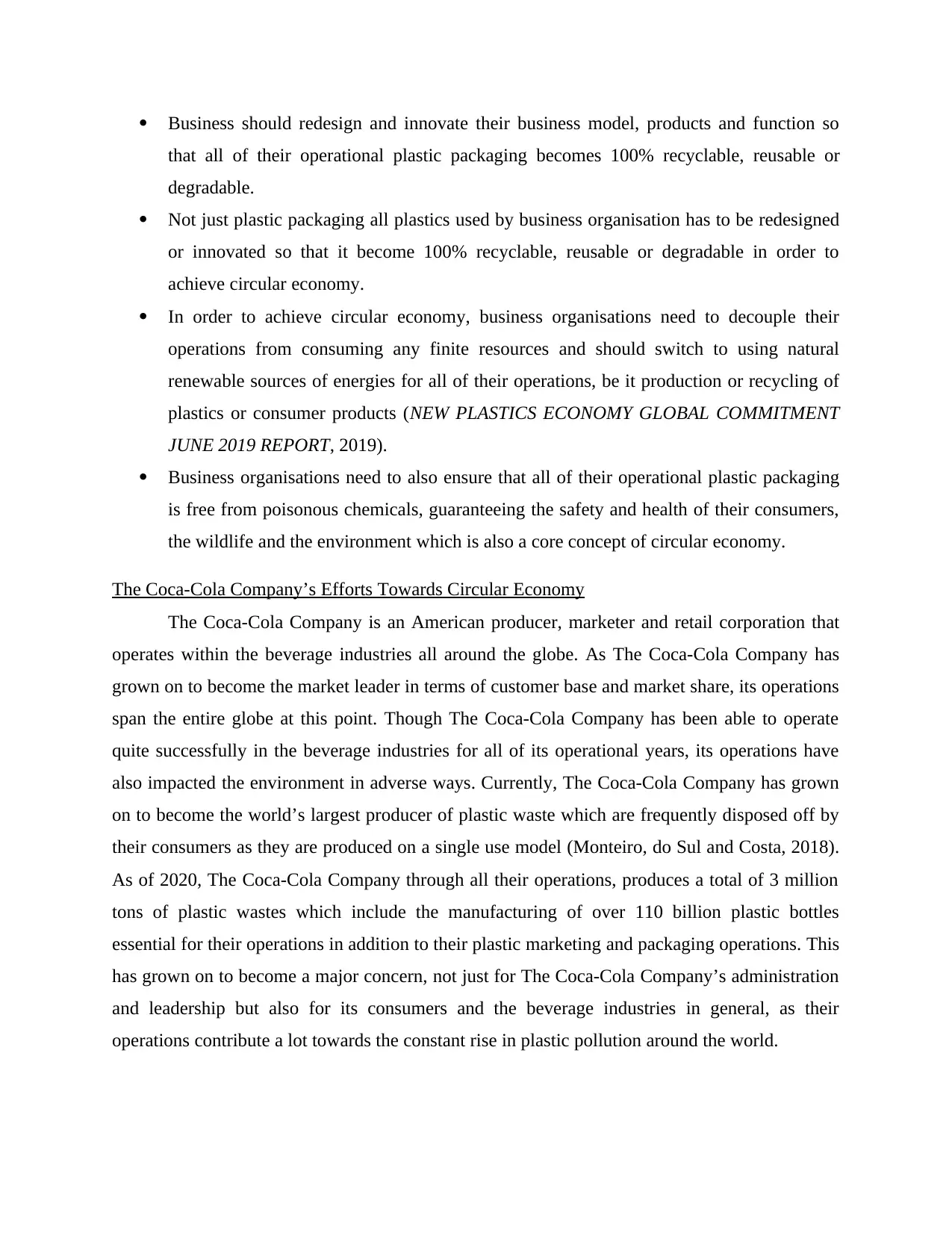
Business should redesign and innovate their business model, products and function so
that all of their operational plastic packaging becomes 100% recyclable, reusable or
degradable.
Not just plastic packaging all plastics used by business organisation has to be redesigned
or innovated so that it become 100% recyclable, reusable or degradable in order to
achieve circular economy.
In order to achieve circular economy, business organisations need to decouple their
operations from consuming any finite resources and should switch to using natural
renewable sources of energies for all of their operations, be it production or recycling of
plastics or consumer products (NEW PLASTICS ECONOMY GLOBAL COMMITMENT
JUNE 2019 REPORT, 2019).
Business organisations need to also ensure that all of their operational plastic packaging
is free from poisonous chemicals, guaranteeing the safety and health of their consumers,
the wildlife and the environment which is also a core concept of circular economy.
The Coca-Cola Company’s Efforts Towards Circular Economy
The Coca-Cola Company is an American producer, marketer and retail corporation that
operates within the beverage industries all around the globe. As The Coca-Cola Company has
grown on to become the market leader in terms of customer base and market share, its operations
span the entire globe at this point. Though The Coca-Cola Company has been able to operate
quite successfully in the beverage industries for all of its operational years, its operations have
also impacted the environment in adverse ways. Currently, The Coca-Cola Company has grown
on to become the world’s largest producer of plastic waste which are frequently disposed off by
their consumers as they are produced on a single use model (Monteiro, do Sul and Costa, 2018).
As of 2020, The Coca-Cola Company through all their operations, produces a total of 3 million
tons of plastic wastes which include the manufacturing of over 110 billion plastic bottles
essential for their operations in addition to their plastic marketing and packaging operations. This
has grown on to become a major concern, not just for The Coca-Cola Company’s administration
and leadership but also for its consumers and the beverage industries in general, as their
operations contribute a lot towards the constant rise in plastic pollution around the world.
that all of their operational plastic packaging becomes 100% recyclable, reusable or
degradable.
Not just plastic packaging all plastics used by business organisation has to be redesigned
or innovated so that it become 100% recyclable, reusable or degradable in order to
achieve circular economy.
In order to achieve circular economy, business organisations need to decouple their
operations from consuming any finite resources and should switch to using natural
renewable sources of energies for all of their operations, be it production or recycling of
plastics or consumer products (NEW PLASTICS ECONOMY GLOBAL COMMITMENT
JUNE 2019 REPORT, 2019).
Business organisations need to also ensure that all of their operational plastic packaging
is free from poisonous chemicals, guaranteeing the safety and health of their consumers,
the wildlife and the environment which is also a core concept of circular economy.
The Coca-Cola Company’s Efforts Towards Circular Economy
The Coca-Cola Company is an American producer, marketer and retail corporation that
operates within the beverage industries all around the globe. As The Coca-Cola Company has
grown on to become the market leader in terms of customer base and market share, its operations
span the entire globe at this point. Though The Coca-Cola Company has been able to operate
quite successfully in the beverage industries for all of its operational years, its operations have
also impacted the environment in adverse ways. Currently, The Coca-Cola Company has grown
on to become the world’s largest producer of plastic waste which are frequently disposed off by
their consumers as they are produced on a single use model (Monteiro, do Sul and Costa, 2018).
As of 2020, The Coca-Cola Company through all their operations, produces a total of 3 million
tons of plastic wastes which include the manufacturing of over 110 billion plastic bottles
essential for their operations in addition to their plastic marketing and packaging operations. This
has grown on to become a major concern, not just for The Coca-Cola Company’s administration
and leadership but also for its consumers and the beverage industries in general, as their
operations contribute a lot towards the constant rise in plastic pollution around the world.
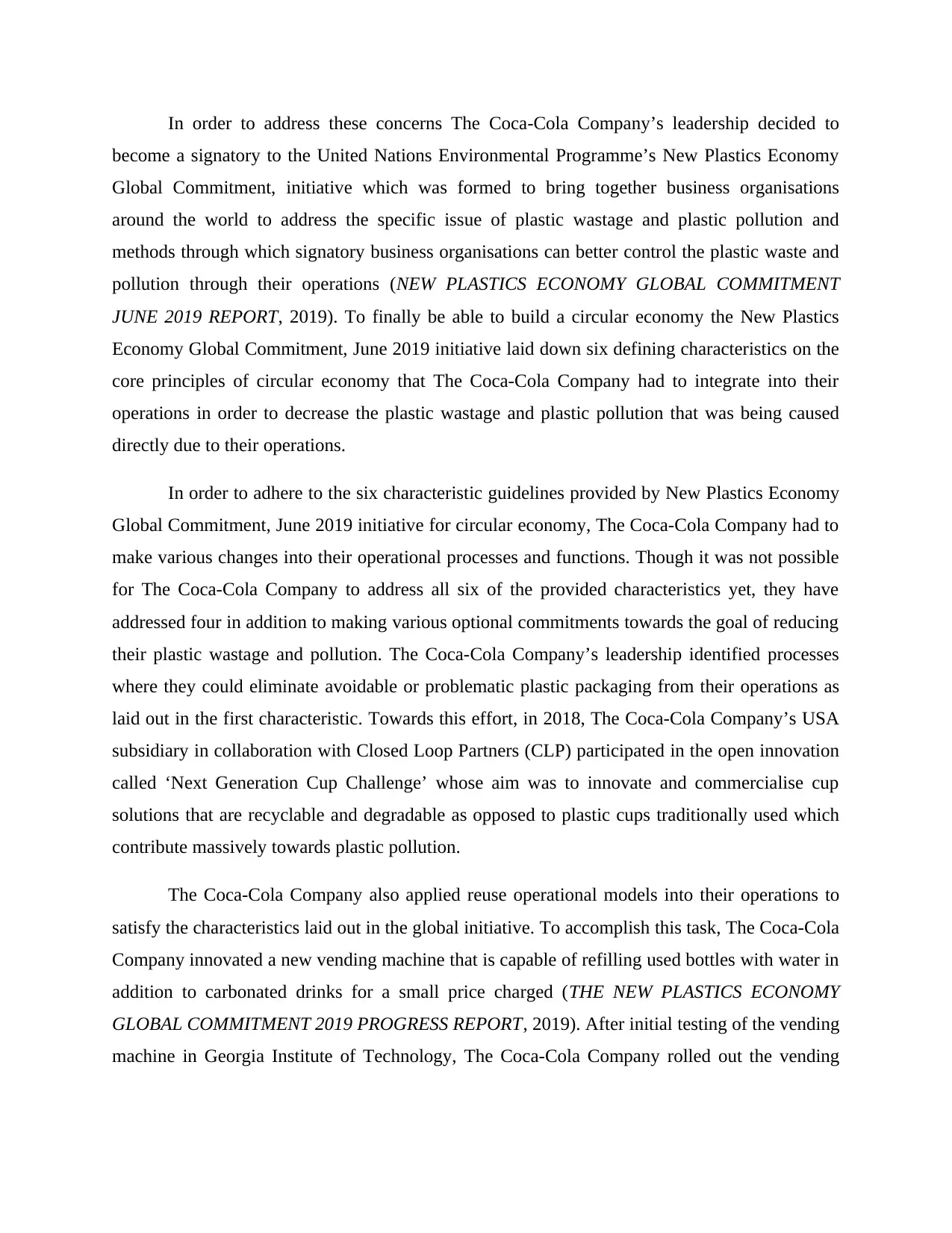
In order to address these concerns The Coca-Cola Company’s leadership decided to
become a signatory to the United Nations Environmental Programme’s New Plastics Economy
Global Commitment, initiative which was formed to bring together business organisations
around the world to address the specific issue of plastic wastage and plastic pollution and
methods through which signatory business organisations can better control the plastic waste and
pollution through their operations (NEW PLASTICS ECONOMY GLOBAL COMMITMENT
JUNE 2019 REPORT, 2019). To finally be able to build a circular economy the New Plastics
Economy Global Commitment, June 2019 initiative laid down six defining characteristics on the
core principles of circular economy that The Coca-Cola Company had to integrate into their
operations in order to decrease the plastic wastage and plastic pollution that was being caused
directly due to their operations.
In order to adhere to the six characteristic guidelines provided by New Plastics Economy
Global Commitment, June 2019 initiative for circular economy, The Coca-Cola Company had to
make various changes into their operational processes and functions. Though it was not possible
for The Coca-Cola Company to address all six of the provided characteristics yet, they have
addressed four in addition to making various optional commitments towards the goal of reducing
their plastic wastage and pollution. The Coca-Cola Company’s leadership identified processes
where they could eliminate avoidable or problematic plastic packaging from their operations as
laid out in the first characteristic. Towards this effort, in 2018, The Coca-Cola Company’s USA
subsidiary in collaboration with Closed Loop Partners (CLP) participated in the open innovation
called ‘Next Generation Cup Challenge’ whose aim was to innovate and commercialise cup
solutions that are recyclable and degradable as opposed to plastic cups traditionally used which
contribute massively towards plastic pollution.
The Coca-Cola Company also applied reuse operational models into their operations to
satisfy the characteristics laid out in the global initiative. To accomplish this task, The Coca-Cola
Company innovated a new vending machine that is capable of refilling used bottles with water in
addition to carbonated drinks for a small price charged (THE NEW PLASTICS ECONOMY
GLOBAL COMMITMENT 2019 PROGRESS REPORT, 2019). After initial testing of the vending
machine in Georgia Institute of Technology, The Coca-Cola Company rolled out the vending
become a signatory to the United Nations Environmental Programme’s New Plastics Economy
Global Commitment, initiative which was formed to bring together business organisations
around the world to address the specific issue of plastic wastage and plastic pollution and
methods through which signatory business organisations can better control the plastic waste and
pollution through their operations (NEW PLASTICS ECONOMY GLOBAL COMMITMENT
JUNE 2019 REPORT, 2019). To finally be able to build a circular economy the New Plastics
Economy Global Commitment, June 2019 initiative laid down six defining characteristics on the
core principles of circular economy that The Coca-Cola Company had to integrate into their
operations in order to decrease the plastic wastage and plastic pollution that was being caused
directly due to their operations.
In order to adhere to the six characteristic guidelines provided by New Plastics Economy
Global Commitment, June 2019 initiative for circular economy, The Coca-Cola Company had to
make various changes into their operational processes and functions. Though it was not possible
for The Coca-Cola Company to address all six of the provided characteristics yet, they have
addressed four in addition to making various optional commitments towards the goal of reducing
their plastic wastage and pollution. The Coca-Cola Company’s leadership identified processes
where they could eliminate avoidable or problematic plastic packaging from their operations as
laid out in the first characteristic. Towards this effort, in 2018, The Coca-Cola Company’s USA
subsidiary in collaboration with Closed Loop Partners (CLP) participated in the open innovation
called ‘Next Generation Cup Challenge’ whose aim was to innovate and commercialise cup
solutions that are recyclable and degradable as opposed to plastic cups traditionally used which
contribute massively towards plastic pollution.
The Coca-Cola Company also applied reuse operational models into their operations to
satisfy the characteristics laid out in the global initiative. To accomplish this task, The Coca-Cola
Company innovated a new vending machine that is capable of refilling used bottles with water in
addition to carbonated drinks for a small price charged (THE NEW PLASTICS ECONOMY
GLOBAL COMMITMENT 2019 PROGRESS REPORT, 2019). After initial testing of the vending
machine in Georgia Institute of Technology, The Coca-Cola Company rolled out the vending
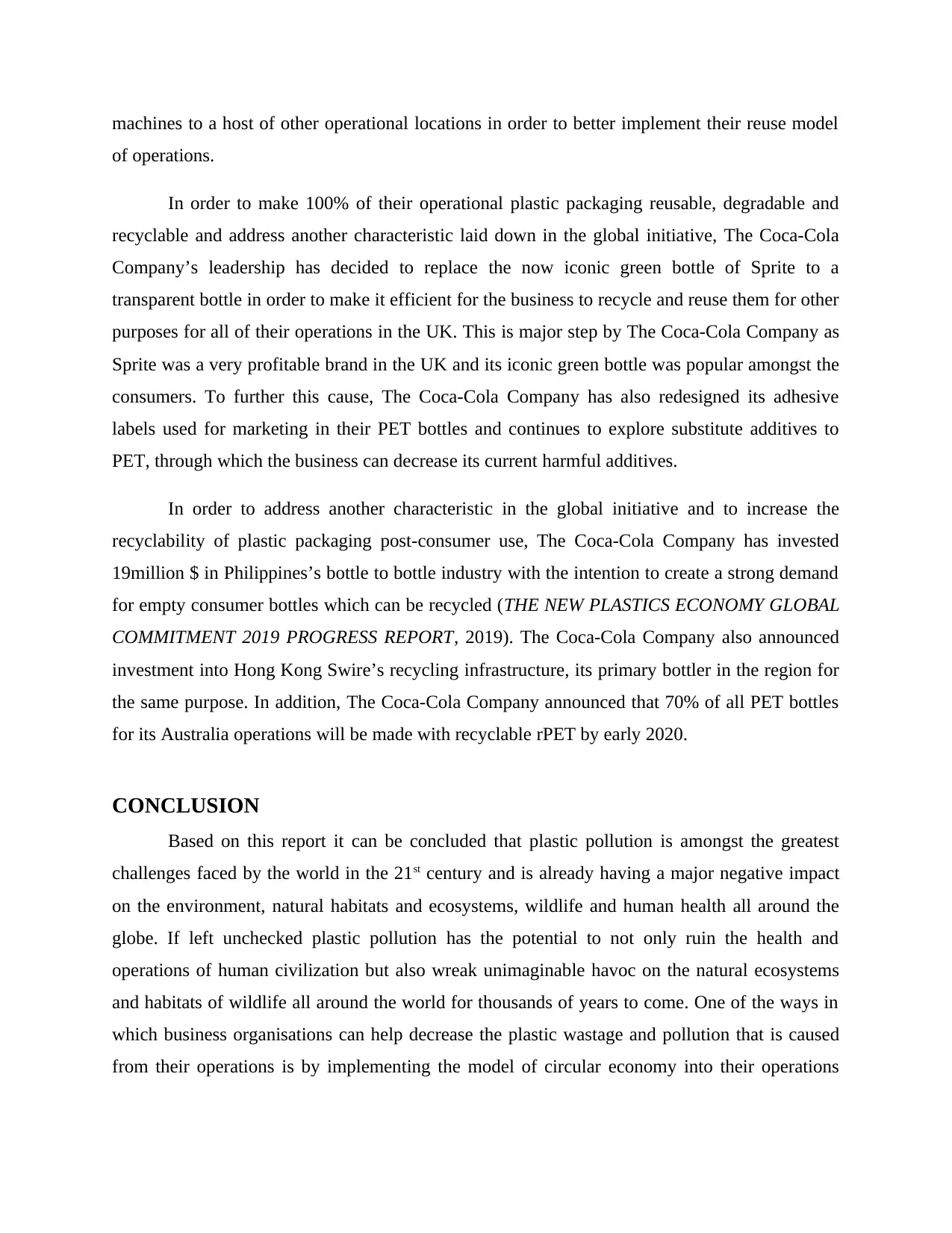
machines to a host of other operational locations in order to better implement their reuse model
of operations.
In order to make 100% of their operational plastic packaging reusable, degradable and
recyclable and address another characteristic laid down in the global initiative, The Coca-Cola
Company’s leadership has decided to replace the now iconic green bottle of Sprite to a
transparent bottle in order to make it efficient for the business to recycle and reuse them for other
purposes for all of their operations in the UK. This is major step by The Coca-Cola Company as
Sprite was a very profitable brand in the UK and its iconic green bottle was popular amongst the
consumers. To further this cause, The Coca-Cola Company has also redesigned its adhesive
labels used for marketing in their PET bottles and continues to explore substitute additives to
PET, through which the business can decrease its current harmful additives.
In order to address another characteristic in the global initiative and to increase the
recyclability of plastic packaging post-consumer use, The Coca-Cola Company has invested
19million $ in Philippines’s bottle to bottle industry with the intention to create a strong demand
for empty consumer bottles which can be recycled (THE NEW PLASTICS ECONOMY GLOBAL
COMMITMENT 2019 PROGRESS REPORT, 2019). The Coca-Cola Company also announced
investment into Hong Kong Swire’s recycling infrastructure, its primary bottler in the region for
the same purpose. In addition, The Coca-Cola Company announced that 70% of all PET bottles
for its Australia operations will be made with recyclable rPET by early 2020.
CONCLUSION
Based on this report it can be concluded that plastic pollution is amongst the greatest
challenges faced by the world in the 21st century and is already having a major negative impact
on the environment, natural habitats and ecosystems, wildlife and human health all around the
globe. If left unchecked plastic pollution has the potential to not only ruin the health and
operations of human civilization but also wreak unimaginable havoc on the natural ecosystems
and habitats of wildlife all around the world for thousands of years to come. One of the ways in
which business organisations can help decrease the plastic wastage and pollution that is caused
from their operations is by implementing the model of circular economy into their operations
of operations.
In order to make 100% of their operational plastic packaging reusable, degradable and
recyclable and address another characteristic laid down in the global initiative, The Coca-Cola
Company’s leadership has decided to replace the now iconic green bottle of Sprite to a
transparent bottle in order to make it efficient for the business to recycle and reuse them for other
purposes for all of their operations in the UK. This is major step by The Coca-Cola Company as
Sprite was a very profitable brand in the UK and its iconic green bottle was popular amongst the
consumers. To further this cause, The Coca-Cola Company has also redesigned its adhesive
labels used for marketing in their PET bottles and continues to explore substitute additives to
PET, through which the business can decrease its current harmful additives.
In order to address another characteristic in the global initiative and to increase the
recyclability of plastic packaging post-consumer use, The Coca-Cola Company has invested
19million $ in Philippines’s bottle to bottle industry with the intention to create a strong demand
for empty consumer bottles which can be recycled (THE NEW PLASTICS ECONOMY GLOBAL
COMMITMENT 2019 PROGRESS REPORT, 2019). The Coca-Cola Company also announced
investment into Hong Kong Swire’s recycling infrastructure, its primary bottler in the region for
the same purpose. In addition, The Coca-Cola Company announced that 70% of all PET bottles
for its Australia operations will be made with recyclable rPET by early 2020.
CONCLUSION
Based on this report it can be concluded that plastic pollution is amongst the greatest
challenges faced by the world in the 21st century and is already having a major negative impact
on the environment, natural habitats and ecosystems, wildlife and human health all around the
globe. If left unchecked plastic pollution has the potential to not only ruin the health and
operations of human civilization but also wreak unimaginable havoc on the natural ecosystems
and habitats of wildlife all around the world for thousands of years to come. One of the ways in
which business organisations can help decrease the plastic wastage and pollution that is caused
from their operations is by implementing the model of circular economy into their operations
Secure Best Marks with AI Grader
Need help grading? Try our AI Grader for instant feedback on your assignments.
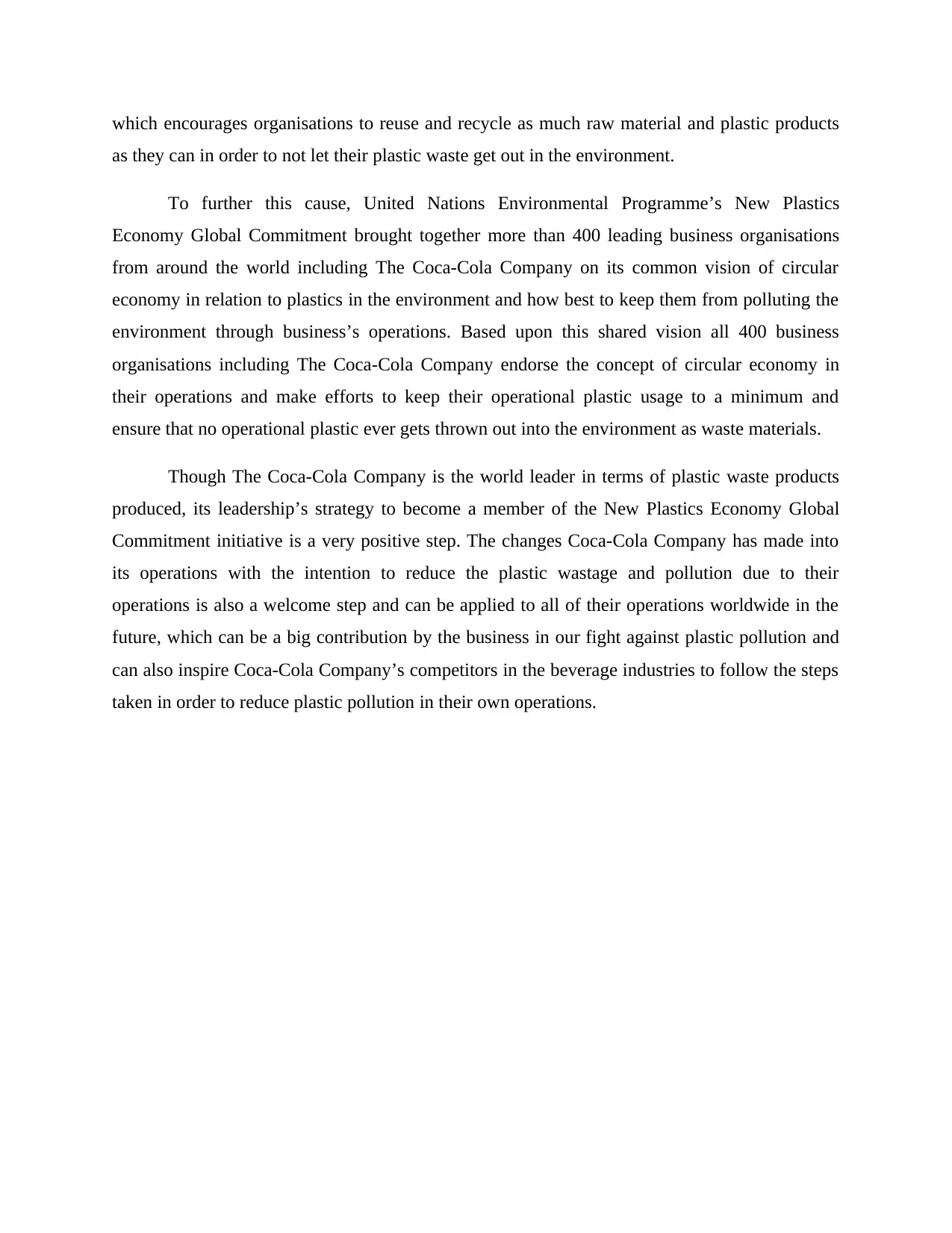
which encourages organisations to reuse and recycle as much raw material and plastic products
as they can in order to not let their plastic waste get out in the environment.
To further this cause, United Nations Environmental Programme’s New Plastics
Economy Global Commitment brought together more than 400 leading business organisations
from around the world including The Coca-Cola Company on its common vision of circular
economy in relation to plastics in the environment and how best to keep them from polluting the
environment through business’s operations. Based upon this shared vision all 400 business
organisations including The Coca-Cola Company endorse the concept of circular economy in
their operations and make efforts to keep their operational plastic usage to a minimum and
ensure that no operational plastic ever gets thrown out into the environment as waste materials.
Though The Coca-Cola Company is the world leader in terms of plastic waste products
produced, its leadership’s strategy to become a member of the New Plastics Economy Global
Commitment initiative is a very positive step. The changes Coca-Cola Company has made into
its operations with the intention to reduce the plastic wastage and pollution due to their
operations is also a welcome step and can be applied to all of their operations worldwide in the
future, which can be a big contribution by the business in our fight against plastic pollution and
can also inspire Coca-Cola Company’s competitors in the beverage industries to follow the steps
taken in order to reduce plastic pollution in their own operations.
as they can in order to not let their plastic waste get out in the environment.
To further this cause, United Nations Environmental Programme’s New Plastics
Economy Global Commitment brought together more than 400 leading business organisations
from around the world including The Coca-Cola Company on its common vision of circular
economy in relation to plastics in the environment and how best to keep them from polluting the
environment through business’s operations. Based upon this shared vision all 400 business
organisations including The Coca-Cola Company endorse the concept of circular economy in
their operations and make efforts to keep their operational plastic usage to a minimum and
ensure that no operational plastic ever gets thrown out into the environment as waste materials.
Though The Coca-Cola Company is the world leader in terms of plastic waste products
produced, its leadership’s strategy to become a member of the New Plastics Economy Global
Commitment initiative is a very positive step. The changes Coca-Cola Company has made into
its operations with the intention to reduce the plastic wastage and pollution due to their
operations is also a welcome step and can be applied to all of their operations worldwide in the
future, which can be a big contribution by the business in our fight against plastic pollution and
can also inspire Coca-Cola Company’s competitors in the beverage industries to follow the steps
taken in order to reduce plastic pollution in their own operations.
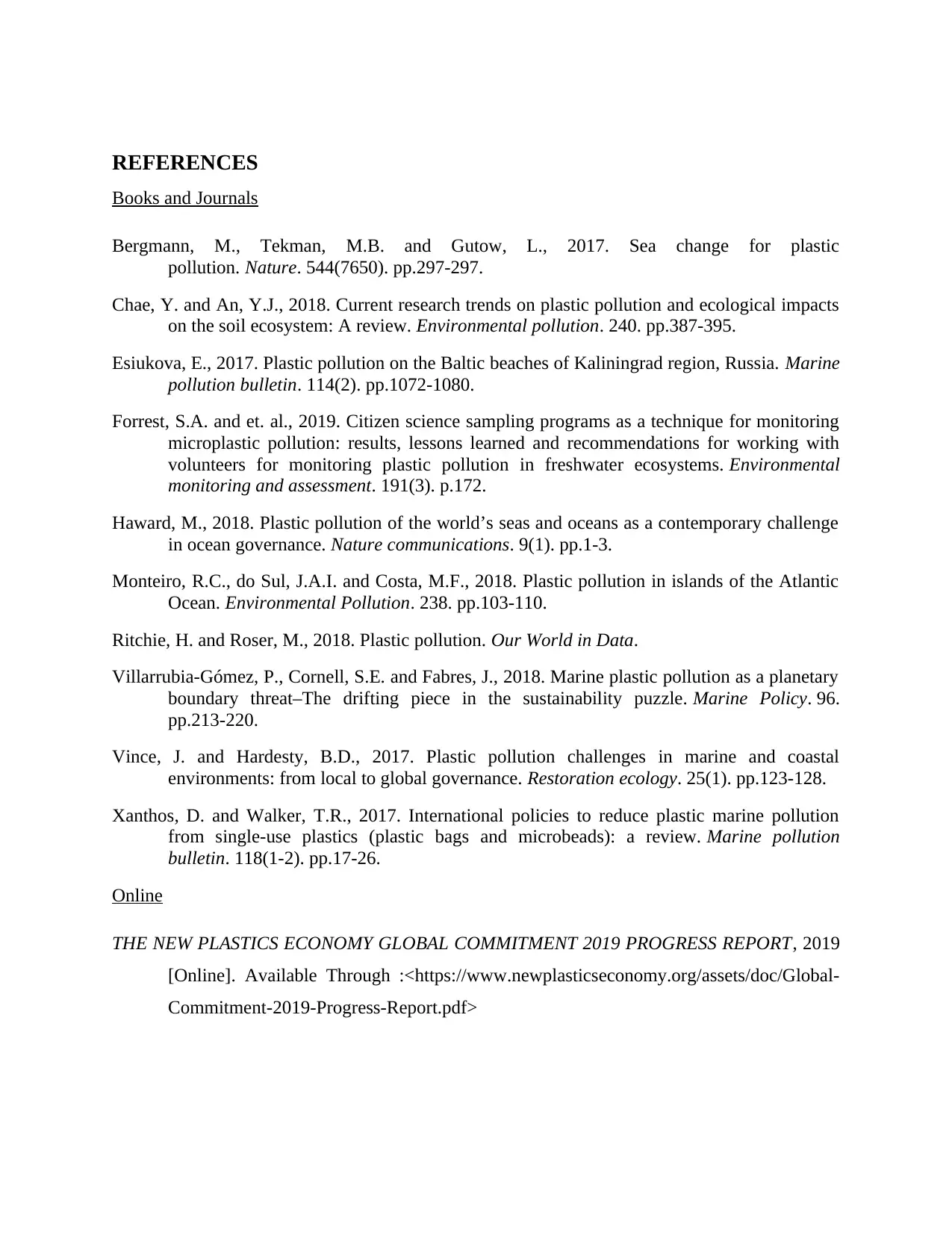
REFERENCES
Books and Journals
Bergmann, M., Tekman, M.B. and Gutow, L., 2017. Sea change for plastic
pollution. Nature. 544(7650). pp.297-297.
Chae, Y. and An, Y.J., 2018. Current research trends on plastic pollution and ecological impacts
on the soil ecosystem: A review. Environmental pollution. 240. pp.387-395.
Esiukova, E., 2017. Plastic pollution on the Baltic beaches of Kaliningrad region, Russia. Marine
pollution bulletin. 114(2). pp.1072-1080.
Forrest, S.A. and et. al., 2019. Citizen science sampling programs as a technique for monitoring
microplastic pollution: results, lessons learned and recommendations for working with
volunteers for monitoring plastic pollution in freshwater ecosystems. Environmental
monitoring and assessment. 191(3). p.172.
Haward, M., 2018. Plastic pollution of the world’s seas and oceans as a contemporary challenge
in ocean governance. Nature communications. 9(1). pp.1-3.
Monteiro, R.C., do Sul, J.A.I. and Costa, M.F., 2018. Plastic pollution in islands of the Atlantic
Ocean. Environmental Pollution. 238. pp.103-110.
Ritchie, H. and Roser, M., 2018. Plastic pollution. Our World in Data.
Villarrubia-Gómez, P., Cornell, S.E. and Fabres, J., 2018. Marine plastic pollution as a planetary
boundary threat–The drifting piece in the sustainability puzzle. Marine Policy. 96.
pp.213-220.
Vince, J. and Hardesty, B.D., 2017. Plastic pollution challenges in marine and coastal
environments: from local to global governance. Restoration ecology. 25(1). pp.123-128.
Xanthos, D. and Walker, T.R., 2017. International policies to reduce plastic marine pollution
from single-use plastics (plastic bags and microbeads): a review. Marine pollution
bulletin. 118(1-2). pp.17-26.
Online
THE NEW PLASTICS ECONOMY GLOBAL COMMITMENT 2019 PROGRESS REPORT, 2019
[Online]. Available Through :<https://www.newplasticseconomy.org/assets/doc/Global-
Commitment-2019-Progress-Report.pdf>
Books and Journals
Bergmann, M., Tekman, M.B. and Gutow, L., 2017. Sea change for plastic
pollution. Nature. 544(7650). pp.297-297.
Chae, Y. and An, Y.J., 2018. Current research trends on plastic pollution and ecological impacts
on the soil ecosystem: A review. Environmental pollution. 240. pp.387-395.
Esiukova, E., 2017. Plastic pollution on the Baltic beaches of Kaliningrad region, Russia. Marine
pollution bulletin. 114(2). pp.1072-1080.
Forrest, S.A. and et. al., 2019. Citizen science sampling programs as a technique for monitoring
microplastic pollution: results, lessons learned and recommendations for working with
volunteers for monitoring plastic pollution in freshwater ecosystems. Environmental
monitoring and assessment. 191(3). p.172.
Haward, M., 2018. Plastic pollution of the world’s seas and oceans as a contemporary challenge
in ocean governance. Nature communications. 9(1). pp.1-3.
Monteiro, R.C., do Sul, J.A.I. and Costa, M.F., 2018. Plastic pollution in islands of the Atlantic
Ocean. Environmental Pollution. 238. pp.103-110.
Ritchie, H. and Roser, M., 2018. Plastic pollution. Our World in Data.
Villarrubia-Gómez, P., Cornell, S.E. and Fabres, J., 2018. Marine plastic pollution as a planetary
boundary threat–The drifting piece in the sustainability puzzle. Marine Policy. 96.
pp.213-220.
Vince, J. and Hardesty, B.D., 2017. Plastic pollution challenges in marine and coastal
environments: from local to global governance. Restoration ecology. 25(1). pp.123-128.
Xanthos, D. and Walker, T.R., 2017. International policies to reduce plastic marine pollution
from single-use plastics (plastic bags and microbeads): a review. Marine pollution
bulletin. 118(1-2). pp.17-26.
Online
THE NEW PLASTICS ECONOMY GLOBAL COMMITMENT 2019 PROGRESS REPORT, 2019
[Online]. Available Through :<https://www.newplasticseconomy.org/assets/doc/Global-
Commitment-2019-Progress-Report.pdf>
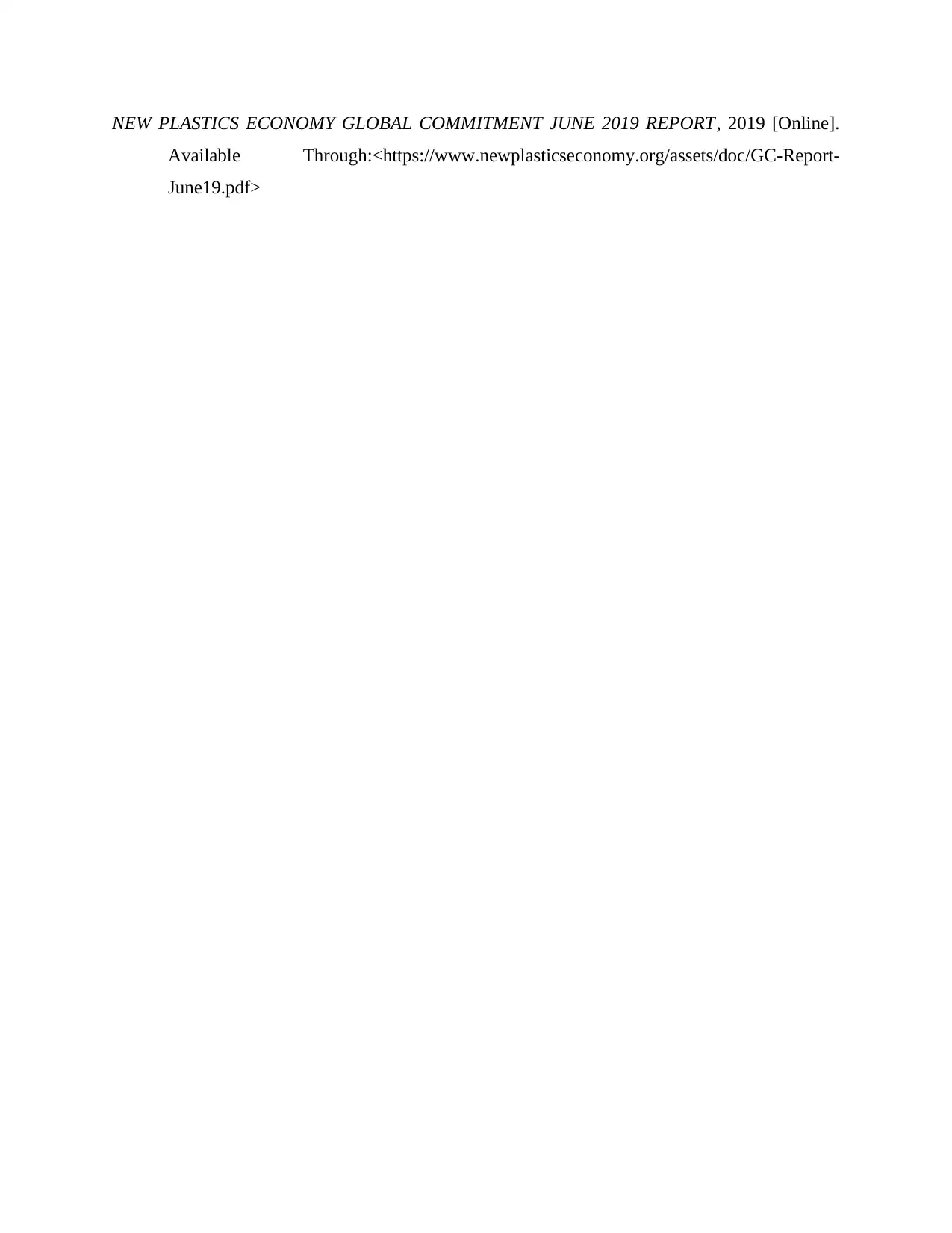
NEW PLASTICS ECONOMY GLOBAL COMMITMENT JUNE 2019 REPORT, 2019 [Online].
Available Through:<https://www.newplasticseconomy.org/assets/doc/GC-Report-
June19.pdf>
Available Through:<https://www.newplasticseconomy.org/assets/doc/GC-Report-
June19.pdf>
1 out of 13
Related Documents
Your All-in-One AI-Powered Toolkit for Academic Success.
+13062052269
info@desklib.com
Available 24*7 on WhatsApp / Email
![[object Object]](/_next/static/media/star-bottom.7253800d.svg)
Unlock your academic potential
© 2024 | Zucol Services PVT LTD | All rights reserved.





